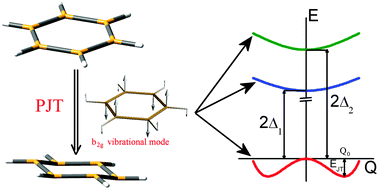Reexamination of the origin of the pseudo Jahn–Teller puckering instability in silicene†
Abstract
Silicene, the graphene-like crystal formed by the Si hexagonal lattice, presents a periodic buckled structure whose origin is due to the pseudo Jahn–Teller instability on each of its planar six membered rings. This has been attributed to the coupling of the planar D6h ground state with the first b2g excited state through a b2g vibrational mode. Here we show, by explicitly calculating the vibronic coupling constants through a complete study of the PJT effect, that the vibronic coupling of the ground state with only one excited state to explain the planar instability is inconsistent with the linear multilevel PJT effect theory. It is also shown that in order to have consistency, the PJT model should include the next excited state, which is symmetry compatible coupled to the puckering mode. This is done by the analysis, based on DFT and TDDFT calculations, of the vibronic instability of the ground state of hexasilabenzene, the basic silicon hydrogenated hexagonal ring unit defining silicene.


 Please wait while we load your content...
Please wait while we load your content...